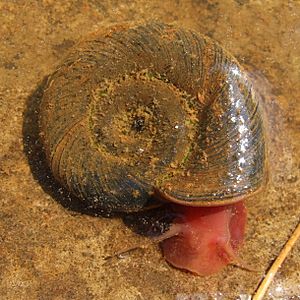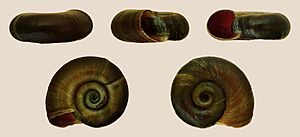Planorbarius corneus facts for kids
Planorbarius corneus, also known as the great ramshorn snail, is a fairly large type of snail that lives in fresh water. It breathes air and is a kind of mollusk. These snails belong to a family called Planorbidae, which are often called ram's horn snails because of their shell shape. All snails in this family have shells that coil to the left, even though they might look like they coil to the right!
Quick facts for kids Planorbarius corneus |
|
|---|---|
 |
|
| A live individual of Planorbarius corneus, carrying the shell with the umbilicus uppermost | |
 |
|
| A shell of Planorbarius corneus | |
| Conservation status | |
| Scientific classification | |
| Subspecies | |
|
|
| Synonyms | |
|
Contents
Where Great Ramshorn Snails Live
The great ramshorn snail can be found across a wide area. They live in western Europe, central Europe, and all the way to the Caucasus mountains. You can also find them north in Siberia and south in the Middle East.
In Europe, they are in countries like Belgium, France, and the British Isles. They are also in Denmark, Finland, Sweden, and Norway. Their range extends through Austria, Germany, the Netherlands, and many other central and eastern European countries. They are also found in parts of western Asia, including Kazakhstan and Turkey.
Sometimes, these snails are sold as pets for aquariums. Because of this, you might find them in small ponds outside their natural home. This happens when people release them or they escape from tanks.
What Great Ramshorn Snails Look Like
All snails in the Planorbidae family have shells that coil to the left. This means if you look at the opening, the shell spirals counter-clockwise.
The Planorbarius corneus is the biggest ramshorn snail in Europe. Its shell usually grows to about 35 millimetres (1.4 in) wide when it's fully grown.
The shell is coiled and measures about 10–17 by 22–40 millimetres (0.39–0.67 by 0.87–1.57 in). It has between 3 and 4.5 rounded sections called whorls. The lines between these sections, called sutures, are quite deep. The top of the shell is slightly sunken, and the bottom is deeply sunken. The shell does not have a sharp edge or "keel."
The shell is usually light yellowish. It can have brown, reddish, or greenish outer layers. It has faint lines that go in circles and outwards from the center. The opening of the shell is wide and almost perfectly round. The snail itself is usually brown or reddish.
-
Together with a Lymnaea stagnalis snail.
-
Eggs, not more than one day old, together with several feeding adults. The clutch is 12 millimeters long. Also, a snail's mouth with its radula can be seen clearly.
Where Great Ramshorn Snails Live
These large ramshorn snails prefer water that is still or moves very slowly. They like places with lots of different kinds of pond plants. They also need water that has high levels of calcium dissolved in it. Calcium helps them build strong shells.
Great Ramshorn Snail Reproduction
These snails reproduce in the spring and autumn. This happens when the water temperature is above 15 °C (59 °F). They lay their eggs in long, clear capsules. Each capsule is about 8–15 mm wide and holds 12 to 40 eggs.
The snails attach these egg capsules to underwater plants. The tiny snail embryos inside the eggs are reddish and have clear shells. Young snails hatch from the eggs after about 14–16 days. These snails can live for up to 3 years.
It's possible for a single snail to lay eggs by itself, without another snail. This is called self-fertilization. If a single snail is released into a new pond, it can start a whole new group of snails. However, only about 5% of the eggs from self-fertilization will hatch.
Great Ramshorn Snails as Aquarium Pets
Planorbarius corneus snails are popular pets for aquariums. You can buy them from special breeders. They are easy to care for because they don't need a very big tank. They also don't need a heater, and the tank usually doesn't need extra oxygen. However, adding oxygen can help tiny living things that clean up snail waste and leftover food.
These snails are said to only eat living plants if there isn't enough other food. They prefer to eat algae and dead plant bits. They need water that is rich in calcium. Depending on your water source, you might need to add extra calcium. You can do this with things like cuttlebone or crushed egg shells.
You can feed these snails any kind of fish food. They also enjoy vegetables like spinach leaves, green lettuce leaves, and zucchini slices. If you feed them leafy greens or vegetables, make sure to remove any leftovers quickly. This helps keep the water clean and healthy for the snails. You might also need to use a water conditioner to remove harmful things like copper or chlorine from the water.
Both the European-Asian P. corneus and the smaller North American Planorbella duryi are known as "Ramshorn snails" in the pet trade. They can be cared for in similar ways. However, adult Planorbella snails are much smaller. Their shells are also smooth and shiny, without the faint lines seen on P. corneus shells.






